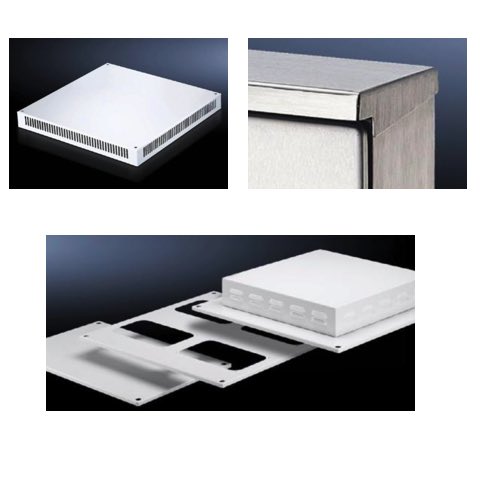Enclosure Roof Plates & Canopies

Enclosure roof plates and canopies are critical components that enhance the functionality, protection, and expandability of electrical enclosures. RSP Supply carries a full line of Rittal roof plates designed to provide a secure and stable mounting platform for accessories such as enclosure fans, ventilation components, and other roof-mounted devices.
Manufactured primarily from durable steel, enclosure roof plates are engineered to withstand environmental exposure and mechanical stress while maintaining enclosure integrity. Their robust construction ensures reliable support for mounted components that are essential for managing internal temperatures, particularly in enclosures housing heat-generating electrical or electronic equipment. Proper roof-mounted ventilation helps improve airflow and contributes to consistent system performance.
Rittal roof plates are designed for seamless integration with compatible enclosure systems. They match enclosure dimensions for a uniform appearance and are engineered for straightforward installation and removal, supporting ease of maintenance and future system modifications. In applications requiring both environmental protection and ventilation, roof plates can be combined with additional enclosure panels or accessories to meet specific operational requirements.
More Information about Enclosure Roof Plates
The installation of roof plates is a straightforward process. They are designed to seamlessly integrate with the existing structure of the enclosure. This design consideration is important for maintaining the overall integrity and functionality of the enclosure. The roof plates typically match the width and other dimensions of the enclosure panels, allowing for a consistent and uniform appearance. In some cases, roof plates can be a part of a combination of panels that make up the enclosure. This combination approach allows for greater flexibility in design and functionality. For example, in enclosures that require both ventilation and protection from environmental elements, roof plates can be combined with other panel types to achieve these objectives.
Additionally, the design of the roof plates often takes into account the need for easy access to the interior of the enclosure. This is especially important for maintenance purposes or when equipment inside the enclosure needs to be inspected or replaced. The ease of installation and removal of these roof plates is therefore a key consideration in their design. Enclosure roof plates play a critical role in providing protection and support for enclosures. Made from durable materials like steel, they offer a stable platform for mounting fans and other components while ensuring the enclosure remains secure and functional. Their design is tailored to complement the enclosure, allowing for easy installation and integration with other enclosure panels.
FAQs
Q: What are enclosure roof plates used for?
Enclosure roof plates provide a secure mounting surface for roof-mounted accessories such as fans, ventilation units, and other components.
Q: Why are roof plates commonly made from steel?
Steel offers strength, durability, and resistance to mechanical stress, making it suitable for supporting mounted components and protecting enclosures.
Q: Can roof plates be removed for maintenance?
Yes. Many roof plates are designed for easy installation and removal, allowing access for maintenance, inspection, or equipment replacement.
Q: Are Rittal roof plates compatible with Rittal enclosures?
Yes. Rittal roof plates are designed specifically to integrate with compatible Rittal enclosure systems.
Q: Do roof plates affect enclosure ratings?
When properly selected and installed according to manufacturer specifications, roof plates help maintain the enclosure’s intended protection and performance.
Why Buy Enclosure Roof Plates & Canopies from RSP Supply
RSP Supply offers a reliable selection of Rittal enclosure roof plates and canopies designed for secure mounting and long-term durability. Our products support effective enclosure customization while maintaining structural integrity and performance. Customers rely on RSP Supply for trusted enclosure components, technical expertise, and solutions that support efficient installation and reliable operation.

